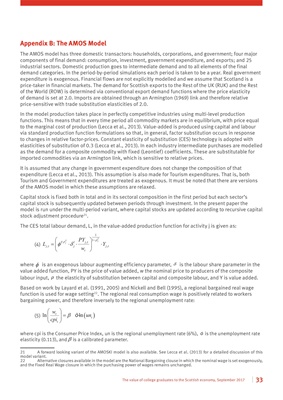
33
The value of college graduates to the Scottish economy, September 2017
Appendix B: The AMOS Model
The AMOS model has three domestic transactors: households, corporations, and government; four major
components of final demand: consumption, investment, government expenditure, and exports; and 25
industrial sectors. Domestic production goes to intermediate demand and to all elements of the final
demand categories. In the period-by-period simulations each period is taken to be a year. Real government
expenditure is exogenous. Financial flows are not explicitly modelled and we assume that Scotland is a
price-taker in financial markets. The demand for Scottish exports to the Rest of the UK (RUK) and the Rest
of the World (ROW) is determined via conventional export demand functions where the price elasticity
of demand is set at 2.0. Imports are obtained through an Armington (1969) link and therefore relative
price-sensitive with trade substitution elasticities of 2.0.
In the model production takes place in perfectly competitive industries using multi-level production
functions. This means that in every time period all commodity markets are in equilibrium, with price equal
to the marginal cost of production (Lecca et al., 2013). Value-added is produced using capital and labour
via standard production function formulations so that, in general, factor substitution occurs in response
to changes in relative factor-prices. Constant elasticity of substitution (CES) technology is adopted with
elasticities of substitution of 0.3 (Lecca et al., 2013). In each industry intermediate purchases are modelled
as the demand for a composite commodity with fixed (Leontief) coefficients. These are substitutable for
imported commodities via an Armington link, which is sensitive to relative prices.
It is assumed that any change in government expenditure does not change the composition of that
expenditure (Lecca et al., 2013). This assumption is also made for Tourism expenditures. That is, both
Tourism and Government expenditures are treated as exogenous. It must be noted that there are versions
of the AMOS model in which these assumptions are relaxed.
Capital stock is fixed both in total and in its sectoral composition in the first period but each sector's
capital stock is subsequently updated between periods through investment. In the present paper the
model is run under the multi-period variant, where capital stocks are updated according to recursive capital
stock adjustment procedure21.
The CES total labour demand, L, in the value-added production function for activity j is given as:
(4)
1
1
,
,,
Y
Y j
j jt
Yl
jt j jt
t
PY
LY
w
ρ
ρ
φδ
−
=
⋅
⋅⋅
where φ is an exogenous labour augmenting efficiency parameter, δ is the labour share parameter in the
value added function, PY is the price of value added, w the nominal price to producers of the composite
labour input, �������� the elasticity of substitution between capital and composite labour, and Y is value added.
Based on work by Layard et al. (1991, 2005) and Nickell and Bell (1995), a regional bargained real wage
function is used for wage setting22. The regional real consumption wage is positively related to workers
bargaining power, and therefore inversely to the regional unemployment rate:
(5) ( )
ln ln
t
t
t
w
un
cpi
β
= −
ò
where cpi is the Consumer Price Index, un is the regional unemployment rate (6%), ò is the unemployment rate
elasticity (0.113), and is a calibrated parameter.
21 A forward looking variant of the AMOSKI model is also available. See Lecca et al. (2013) for a detailed discussion of this
model variant.
22 Alternative closures available in the model are the National Bargaining clouse in which the nominal wage is set exogenously,
and the Fixed Real Wage closure in which the purchasing power of wages remains unchanged.
β